Museum Eye
Published in Issue 5 (Sep/Oct 2005), Reviews, Volume 13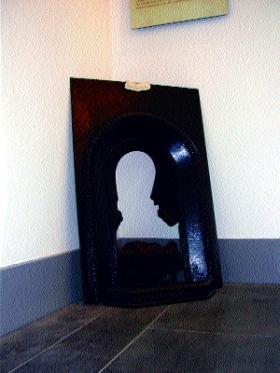
Fireplace from Michael and Mary Davitt’s first home, Land League Cottage, Ballybrack, retrieved when the house was demolished.
Michael Davitt Museum
Straide, Co. Mayo
Open all year 10am–6pm daily. 094-31022/31942. davitt-museum@eircom.net
www.museumsofmayo.com/davitt
by Carla King
On 1 February 1880, in one of the set-pieces of the land war, Michael Davitt addressed a Land League demonstration from a platform erected over the site of the house from which his family had been evicted 30 years before, vowing to dedicate his life to the overthrow of landlordism. Within sight of that spot is the seventeenth-century church where he was christened, which now houses the Michael Davitt Museum, his grave lying in the churchyard beside it. The museum is the achievement of the Davitt Association, formed in November 1972, initially to clear the area around the grave and repair its Celtic cross.
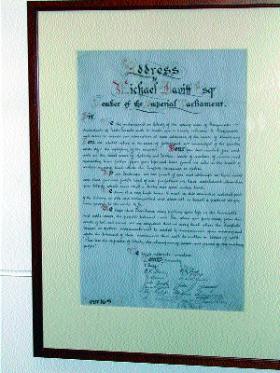
An address to Davit
Its aims expanded over the years to include the landscaping of the area, the construction of a museum, the erection of a statue of Davitt, the promotion of research into his ideas and contribution, the dissemination of information about him through publications and documentaries, and the holding of commemorations connected with his life.
The first museum consisted of a room in a community hall built by the Association in 1984. However, as more material was gathered, it became evident that a larger space was needed, and in 1990 the bishop of Achonry, Revd Dr Thomas Flynn, donated the then derelict church for use as a display area. Prior to the rebuilding, however, two archaeological excavations were carried out on the site on behalf of the OPW, in 1997 and 1999. These uncovered the original walls of the pre-existing Dominican abbey running under the church building that now houses the museum. The excavation and reconstruction work is documented by photographs on display in the museum, and the lines of the abbey walls are indicated in the floor. The new museum was formally opened by An Taoiseach, Bertie Ahern, in October 2000. The Association’s next project is its preparation to mark the centenary of Davitt’s death with a series of events to be held in May 2006.
One of the most popular of the late nineteenth-century leaders, Davitt’s name has always been associated with the Land League, which began the transformation of landholding in Ireland from landlordism to peasant ownership. His legacy is wider than this, however, as his activities spanned many spheres, including support for land nationalisation and radical politics. He was a campaigning journalist, a nationalist MP, a defender of the disadvantaged, from prisoners to the poor, Jews, aboriginal peoples and Indians under the Raj, a supporter of the rights of women and an advocate of multi-denominational education. Closely involved in the labour movement in Britain and Ireland, he was also a founding patron of the GAA and an advocate of the wider use of the Irish language. Author of six books and an indefatigable public speaker, his was an influential, if minority, voice in his lifetime.
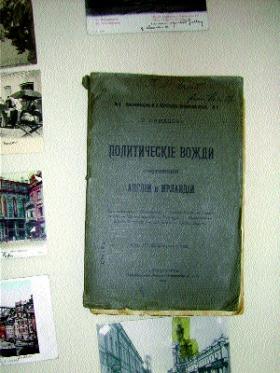
Cover of a book entitled Political leaders of modern England and Ireland (in Russian) by O. Pimenov, signed by the author for Davitt. One of the chapters is on Davitt.
In accordance with his will, which requested that his funeral should be a simple one and that if he died in Ireland he should be returned to his birthplace, his body was buried at Straide on 2 June 1906.
The museum houses a wide range of artefacts and documents associated with Davitt’s life, many of which have been generously donated by the Davitt family. There are family photographs and images of the town of Haslingden, to which Martin and Catherine Davitt brought their children after their eviction, and of the factory in which the eleven-year-old Michael lost his arm in an accident. Letters to and from Davitt on display in the museum include one that he sent to his mother from prison. There are images of the land struggle and Land League memorabilia, including posters announcing meetings, elaborately decorated membership cards and banners. Even drums from the marching bands that escorted the speakers to public meetings are on view in the collection, as is a fireplace from Land League Cottage, the house donated to Davitt and his wife, and silver napkin rings owned by the family.
In 1885 Davitt travelled to Palestine, and his diaries and notebooks describe him gathering shells at the Dead Sea and dried flowers, stones and olive leaves as mementoes of the trip. Remarkably, these have survived and are on show. Later, as his travels took him from his family it was his custom to send home postcards to his children, examples of which are displayed. Popular feeling for the man may be gauged from the tone of the public addresses presented to him, several of which now hang on the walls of the museum. One case contains the freedom chest presented to Davitt on his being granted the freedom of Limerick city in 1884. Several portraits hang on the walls and there is a fine statue of him outside the entrance. A video on his life may be viewed by visitors.
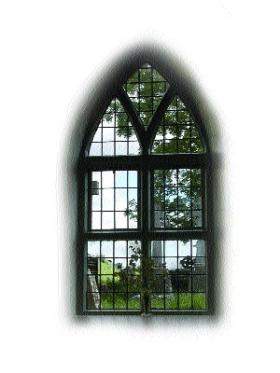
Window of the museum looking out onto the graveyard.
The Association has had to contend with several difficulties. The first that strikes the visitor is the total absence of signposting. Sixteen years after the existing signs were removed by Mayo County Council, there is nothing to indicate to the traveller that a museum commemorating one of Mayo’s more illustrious sons lies only a short distance from the N5 motorway. Like many similar collections, the museum suffers from a combination of shortage of space and lack of funding. It possesses, to take one example, a fine holding of press-cuttings relating to Davitt’s life and obituaries from papers in Ireland, Britain and abroad. As might be expected of newsprint almost 100 years old, these are in urgent need of conservation and storage to ensure their availability to researchers in the future. The museum cases need replacing, and ultra-violet filters on the windows would prevent the deterioration of the material on show. The exigencies of the building, a protected monument in its own right, prevent the provision of a coffee shop, research space or audio-visual room.
Nevertheless, the committee is planning a range of activities for next year to mark the centenary of Davitt’s death, including a symposium, a pageant and a wreath-laying ceremony at his grave on Tuesday 30 May, the date he died in Dublin at the early age of 60. Events elsewhere will include a range of activities in Haslingden in Lancashire;
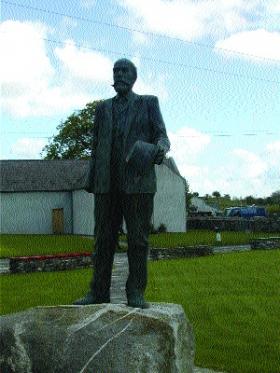
Statue of Davitt in front of the museum.
an exhibition detailing Davitt’s life by the artist Brendon Deasy at Kilmainham Jail; and a weekend conference on 26–28 May, to be held at St Patrick’s College, Drumcondra.
Carla King is a lecturer in modern history at St Patrick’s College, Drumcondra, and a research fellow of the Irish Council for the Humanities and Social Sciences.
















